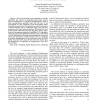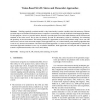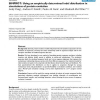32 search results - page 6 / 7 » Building Multi-Level Models: From Landscapes to Landmarks |
3DPVT
2006
IEEE
13 years 12 months ago
2006
IEEE
Range sensing technology allows the photorealistic modeling of large-scale scenes, such as urban structures. The generated 3D representations, after automated registration, are us...
ECCV
2002
Springer
14 years 7 months ago
2002
Springer
We describe an automatic method for building optimal 3D statistical shape models from sets of training shapes. Although shape models show considerable promise as a basis for segmen...
ICRA
2005
IEEE
13 years 11 months ago
2005
IEEE
— The recent progress in robot mapping (or SLAM) algorithms has focused on estimating either point features (such as landmarks) or grid-based representations. Both of these repre...
IJCV
2007
13 years 5 months ago
2007
Building a spatially consistent model is a key functionality to endow a mobile robot with autonomy. Without an initial map or an absolute localization means, it requires to concurr...
BMCBI
2005
13 years 5 months ago
2005
Background: General protein evolution models help determine the baseline expectations for the evolution of sequences, and they have been extensively useful in sequence analysis an...



